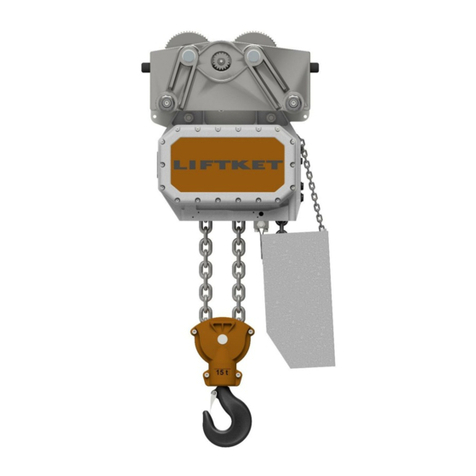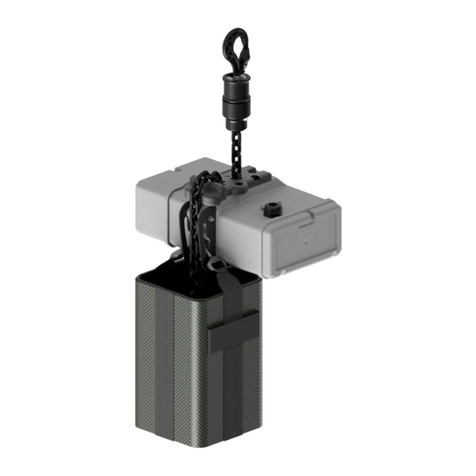
5
1 General information
The supplement to the operating instruction for electric chain hoists with frequency inverter (VFD series) is only valid in con-
nection with the main operating instruction for electric chain hoists. It only describes the specific operation and possible fault
messages of the electric chain hoists with frequency converter.
The special mentioned points of the supplement to the operating instruction for electric chain hoists with frequency inverter
have priority over the main operating instruction for electric chain hoists.
The electric chain hoists of the VFD series are equipped as standard with:
- A frequency inverter control integrated in the electric chain hoist
- Emergency stop button
- Limit switches for lifting and lowering
- Thermal protection
- Load-dependent control of the lifting speed
- Load spectrum counter in the control.
If there are questions concerning the electric chain hoists with frequency inverter (VFD series), please be prepared to pro-
vide the following data:
- Serial number of the electric chain hoist (see type plate)
- Software version of the frequency inverter (see label at the frequency inverter, under the control cap).
2 Technical Overview
2.1 Operating Voltage / Control Voltage
The electric chain hoists of the VFD series are suitable for operation on either 1-phase or 3-phase mains. The connection
voltage can be found on the type plate or in the inspection book.
The control voltage is 24 VDC.
2.2 VFD Layout
Cap on brake side
Control cap
Display
Figure 1: VFD Layout
3 Operating of the VFD Electric Chain Hoists
The electric chain hoist is operated via a two-stage control pendant with emergency stop.
Two different operating modes are possible, the Reduce Speed Mode and the Hold Speed Mode. Alternatively, the selec-
tion of a control pendant with analog push-buttons for stepless control of the lifting and lowering movement is possible.
The minimum speed at minimum frequency shall only be used for final positioning of the load.
The minimum speed at minimum frequency must not be used to lift or lower the load over the
entire lifting height or long hook paths.
Pressing / pushing the emergency stop button stops any lifting and lowering movement immediately and the brake en-
gages.
The emergency stop button can be unlocked again by turning it to the right. Before unlocking/resetting the cause for actuat-
ing the emergency stop button must be checked and eliminated.





























